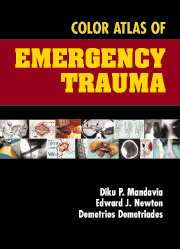2 - FACIAL INJURY
Published online by Cambridge University Press: 10 November 2010
Summary
Introduction
Soft tissue injuries of the face are common in modern society. The majority of serious injuries occur in the context of vehicular trauma or assaults. Use of seatbelts and airbags has decreased the frequency but not eliminated facial trauma produced by motor vehicle accidents. In addition to direct impact of the face against the windshield, steering wheel, or dashboard, broken glass fragments frequently produce lacerations and eye injuries.
The lower face and neck contain structures that define and maintain the patency of the airway. Consequently, facial injuries at times assume the highest priority in trauma management until airway patency and adequate ventilation can be established. Because facial tissues are highly vascularized, massive bleeding into the oral cavity can occlude the airway, especially when patients are obtunded from head injury or intoxication. In the presence of massive bleeding, airway compromise may be produced by placing the patient supine for spinal immobilization. Blood, secretions, fragments of teeth, and foreign bodies must be removed to avoid aspiration and airway occlusion. Although severe facial injuries are dramatic and often distract the inexperienced clinician from more critical tasks, treatment of most facial injuries can be safely deferred until lifethreatening problems have been addressed.
The face and scalp also contain many structures that are essential for the function of special senses of sight, smell, taste, and hearing. Human communication is dependent not only on facial structures required for speech and hearing but also those involved in facial expression. In addition, many facial landmarks define human appearance, and their preservation as intact symmetrical structures is important cosmetically and psychologically.
- Type
- Chapter
- Information
- Color Atlas of Emergency Trauma , pp. 33 - 56Publisher: Cambridge University PressPrint publication year: 2003



